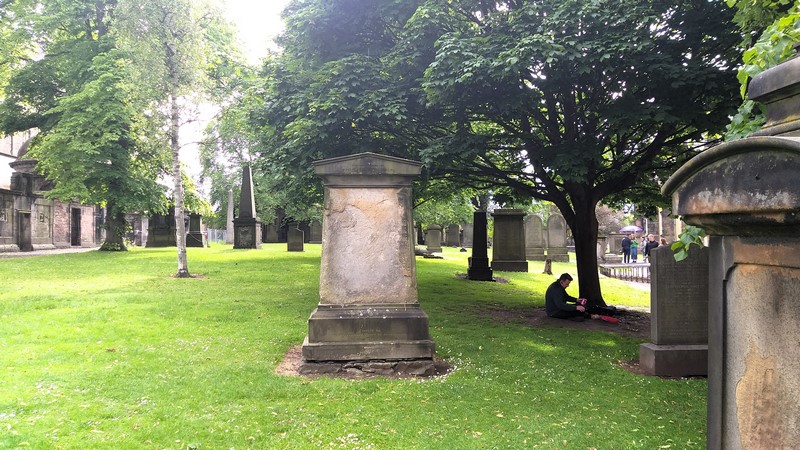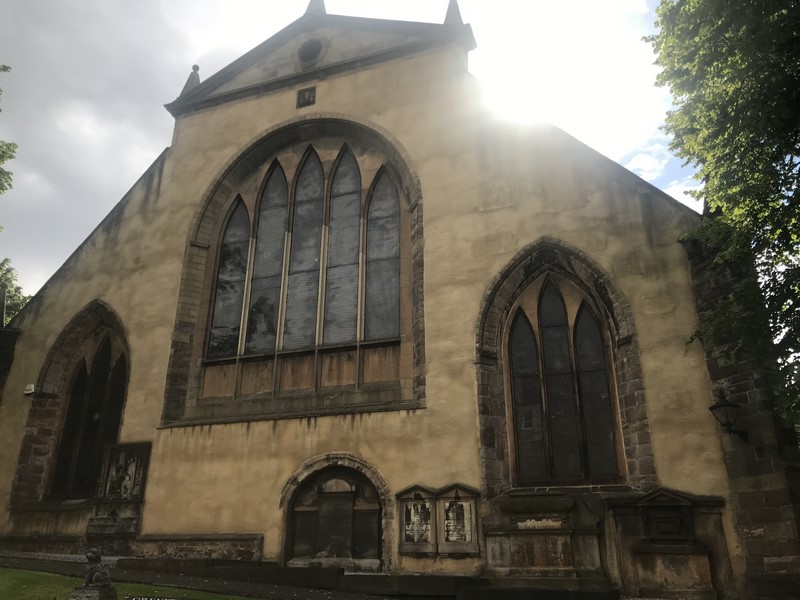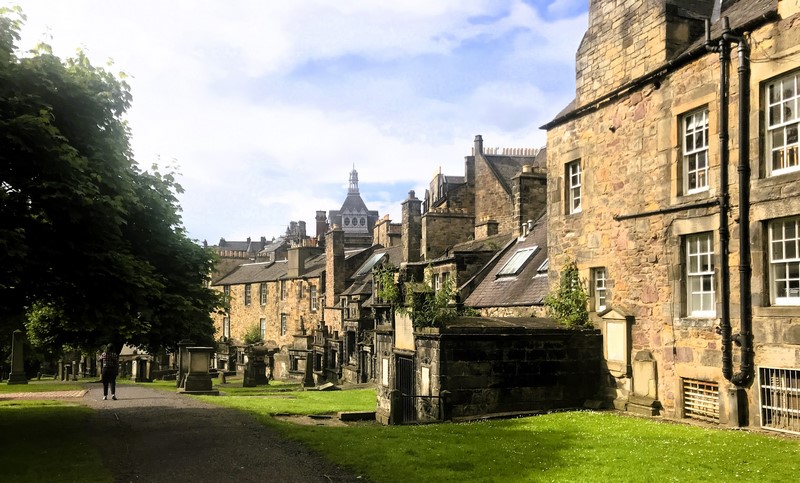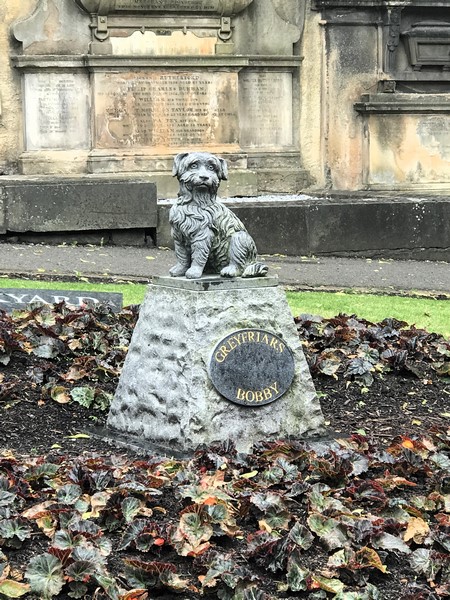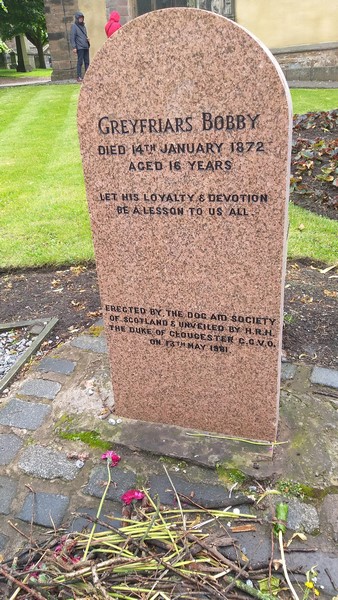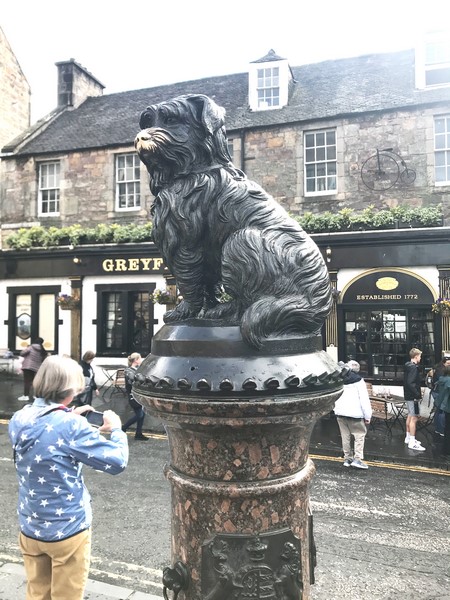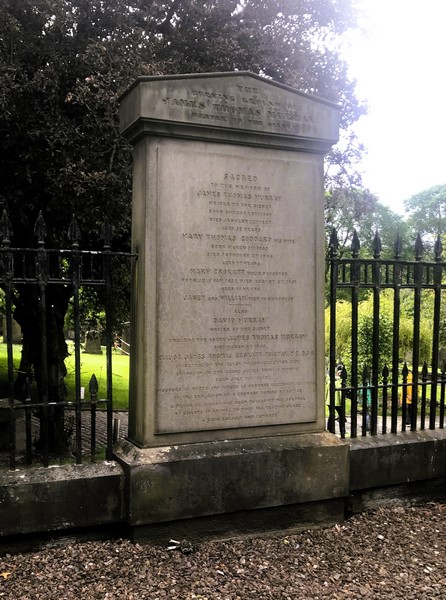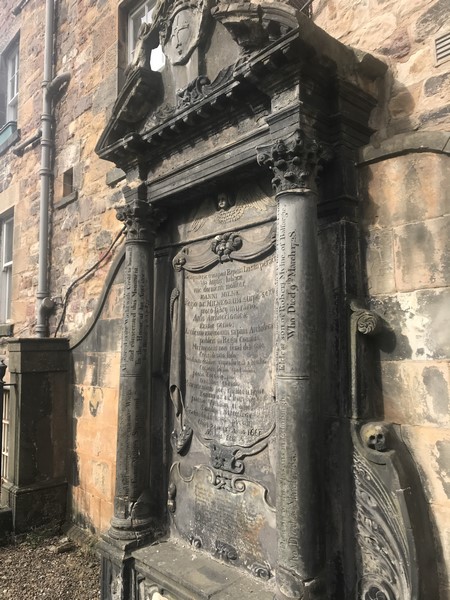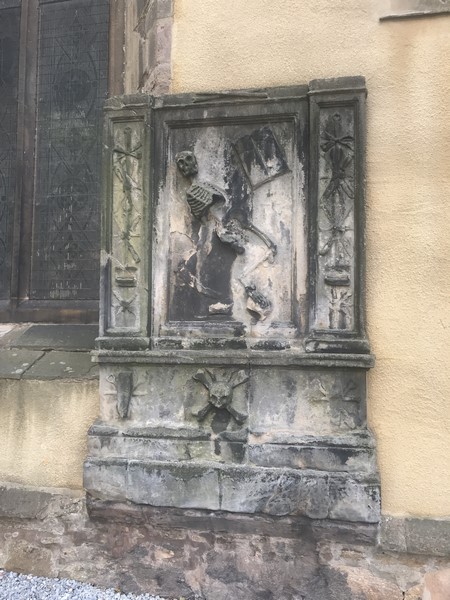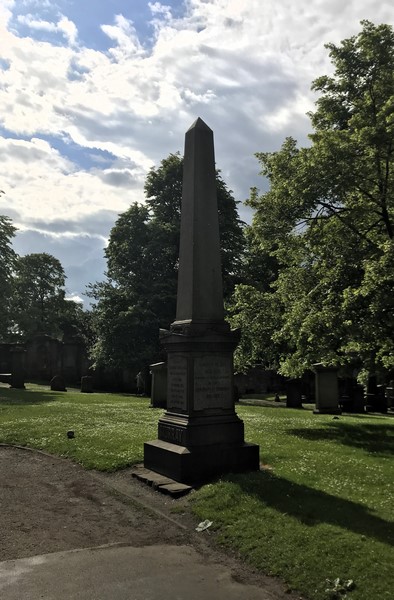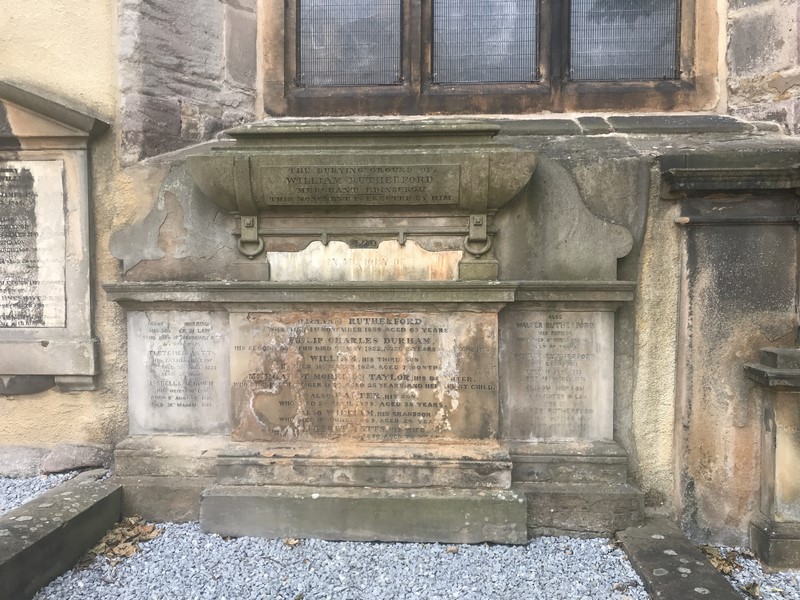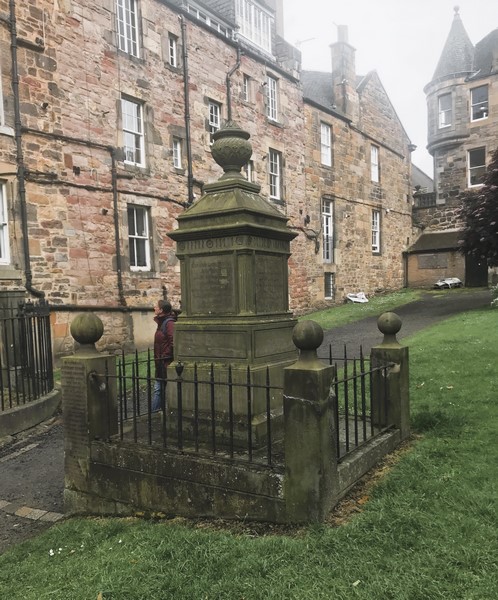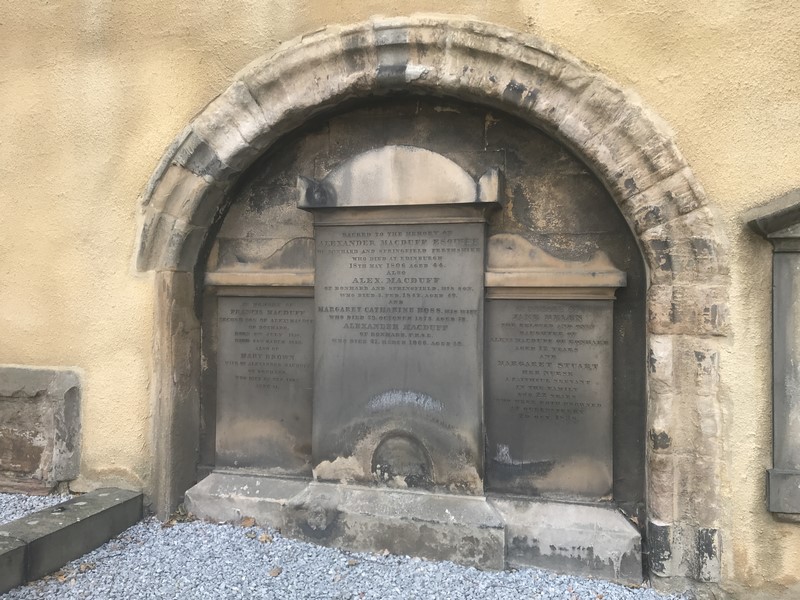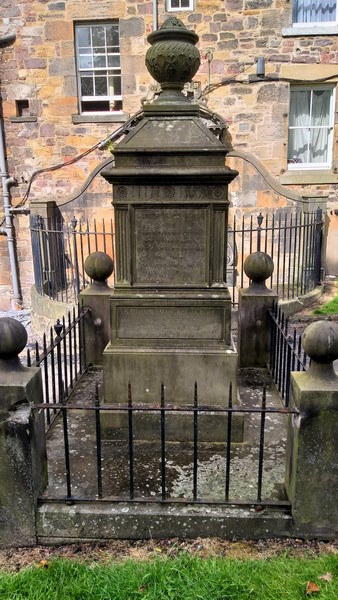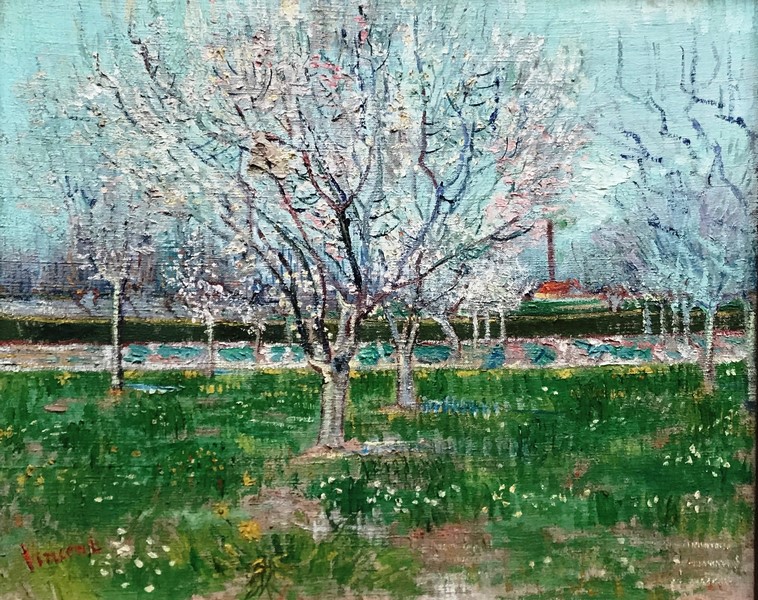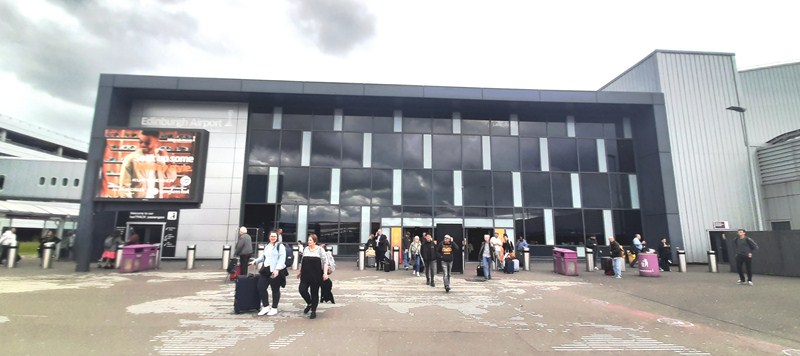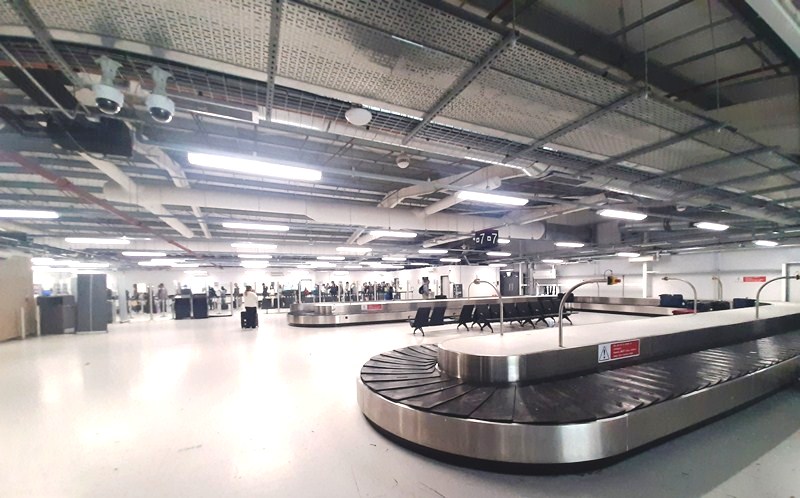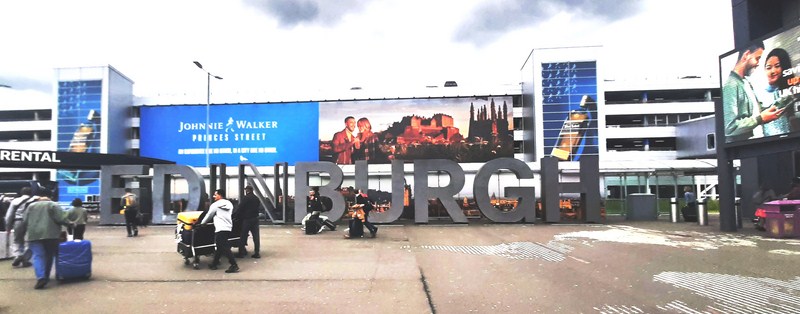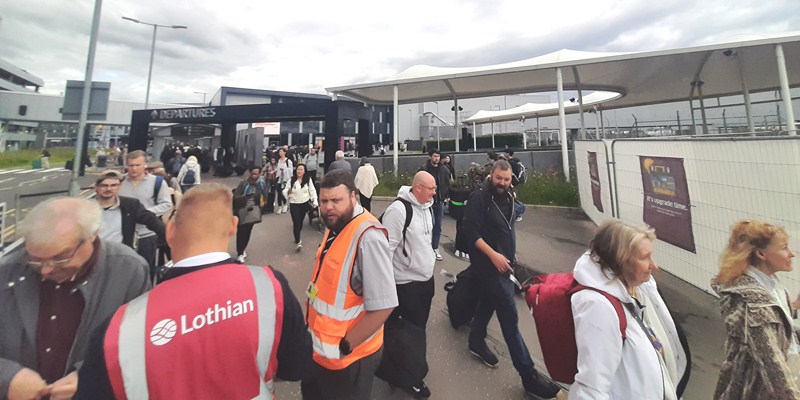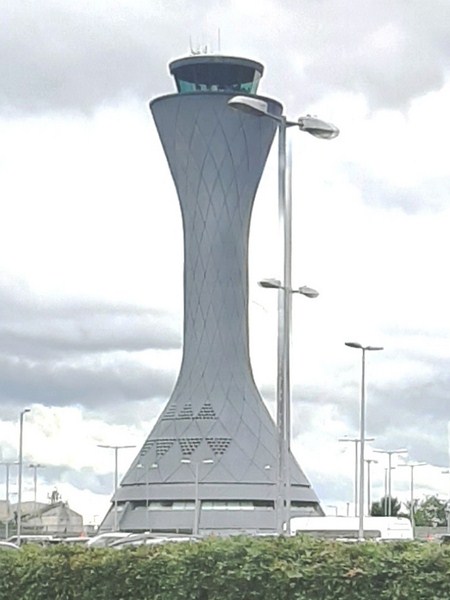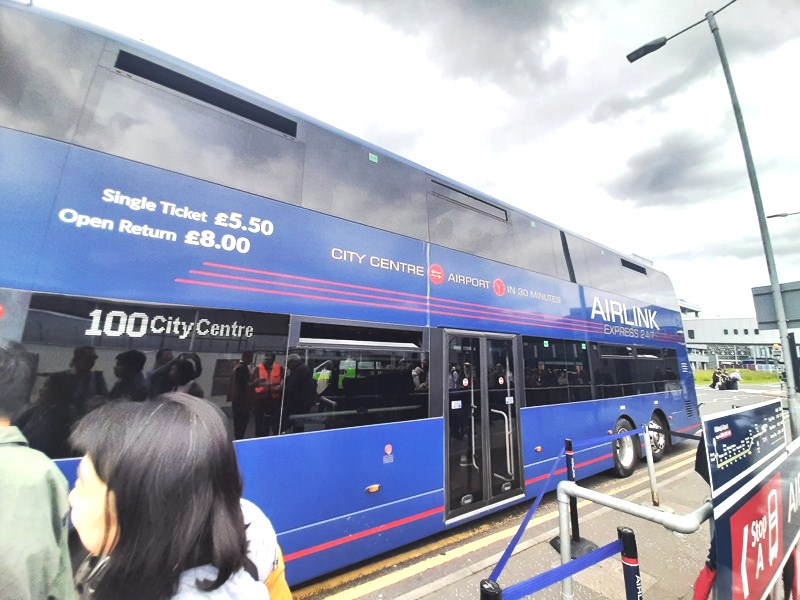On our way to St. Giles Cathedral, we made a stopover at Greyfriars Kirkyard, the graveyard surrounding Greyfriars Kirk, a parish church of the Church of Scotland constructed between 1602 and 1620. Located at the southern edge of the Old Town, it is adjacent to George Heriot’s School.
Check out “St. Giles Cathedral”
Since the late 16th century, burials have been taking place here and a number of notable Edinburgh residents are interred at Greyfriars. Operated by the City of Edinburgh Council, in liaison with a charitable trust, which is linked to but separate from the church, the Kirkyard and its monuments are protected as a category A listed building. The name Greyfriars is taken from the Observantine Franciscans friary (dissolved in 1560) whose friars of wear grey habits.
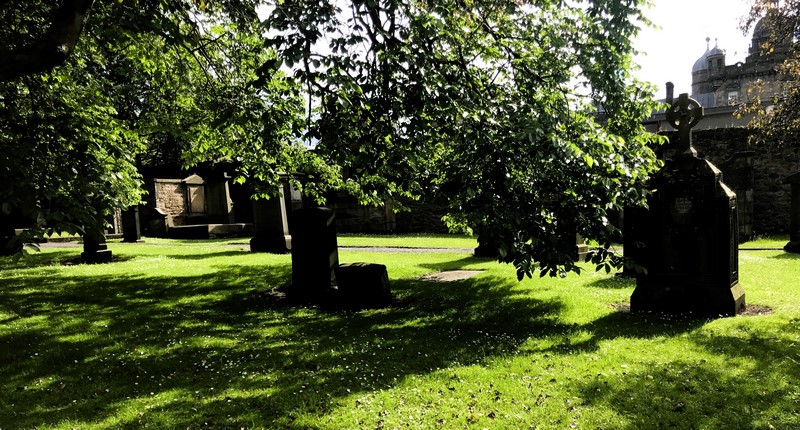
The graveyard is associated with Greyfriars Bobby, the loyal Skye Terrier or Dandie Dinmont Terrier dog who spent 14 years guarding the grave of his master John Gray (a nightwatchman for the Edinburgh City Police who died on February 15, 1858) until his death on January 14, 1872. This tale of a dog’s devotion is similar to that of Hachiko, the faithful Japanese Akita dog of Prof. Hidesaburō Ueno in the 1920s.
Check out “Hachiko Memorial Statue”
Bobby’s headstone, erected by the Dog Aid Society in 1981, is located at the entrance to the Kirkyard to mark his reputed burial place. However, as there are no parts of the kirkyard that is not consecrated, it is also believed he was buried under a tree outside the gates to the right of the current main entrance.
A drinking fountain, topped with Bobby’s statue, sculpted by William Brodie, was commissioned by English philanthropist Lady Burdett-Coutts who was charmed by the story. It was erected, in 1873, at the junction of George IV Bridge and Candlemaker Row, opposite the entrance to the churchyard.
The graveyard is also said to be one of the most haunted in the world and most of those hauntings are linked to the ghost of Lord Advocate Sir George Mackenzie (1636–1691), the merciless judge who, in the 1670s, presided over the trials of the Presbyterian Covenanters who petitioned the King to allow freedom to practice their religion without interference. The Kirkyard was involved in the history of the Covenanters whose movement began with the signing, on February 28, 1638, of the National Covenant in Greyfriars Kirk as it was a place of free legal public assembly.
Following the defeat of the militant Covenanters at the Battle of Bothwell Bridge on June 22, 1679, Bloody Mackenzie imprisoned some 400 (out of 1,200 brought to Edinburgh) Covenanters in a makeshift “prison” at a field to the south of the churchyard, spending four months outside while awaiting trial. It has been described as the world’s first concentration camp. In the 18th century, part of this field was amalgamated into the churchyard, as vaulted tombs, and the area became known as the “Covenanters’ Prison.”
In a twist of faith, Sir George Mackenzie is buried in an Italianate monument (also known as the “Black Mausoleum”), just around the corner from Covenanters’ Prison, one of the most notable monuments in the graveyard The distinctive domed tomb, designed by the architect James Smith, was modelled on the Tempietto di San Pietro (designed by Donato Bramante).
Mackenzie may be dead and gone, but his spirit is said to live on as the Mackenzie Poltergeist who physically attacks people. In fact, by special arrangement with the guides at Greyfriars Kirk, the area is accessible, during the day, during their opening hours, and at night by going on a City of the Dead Tour where you can visit the mausoleum.
In the 1840s, during the early days of photography, the kirkyard was used by David Octavius Hill and Robert Adamson as a setting for several portraits and tableaux such as The Artist and The Gravedigger.
Some of Scotland’s finest mural monuments, from the early 17th century, are mostly found along the east and west walls of the old burial yard to the north of the kirkyard. Rich in symbolism of both mortality and immortality, they include the Death Head, Angel of the Resurrection, and the King of Terrors.
Other notable monuments include the Martyr’s Monument, which commemorates executed Covenanters; the memorial to Gaelic poet Duncan Ban MacIntyre (1724–1812, renovated in 2005, at a cost of about £3,000, raised by a fundraising campaign for over a year); and the monument of Sir John Byres of Coates (1569–1629), one of the last works of the royal master mason William Wallace.
Other notable burials here include:
- William Adam of Blair Adam(1751–1839) – judge
- William Adam(1689–1748) with his son John Adam (1721–1792), both architects.
- Alexander AdieFRSE (1775–1859) – optical instrument maker
- David Aikinhead(1566–1637) – twice Lord Provost of Edinburgh, 1620 to 1622 and 1625 to 1630
- William Annand(1633–1681) – minister and Dean of Giles Cathedral
- Robert Baird of Saughtonhall(1630–1697) – Cashier of the Scottish Carolina Company
- John Bayne of Pitcairlie(1620–1681) – writer to the Signet
- Leslie Balfour-Melville(1854–1937) – golfer
- John Beugo(1759–1841) – engraver
- Joseph Black(1728–1799) – physician (CP)
- Hugh Blair (1718–1800)
- Sir James Hunter Blair, 1st Baronet(1741–1787)
- Robert Blair, Lord Avontoun(1741–1811) – judge (CP)
- Very Rev Andrew Brown(1763–1834) – minister and historian of Nova Scotia
- George Buchanan(died 1582) – historian and reformer
- James Buchanan of Drumpellier(1726–1786), twice Lord Provost of Glasgow after whom Buchanan Street is named
- James Burnett, Lord Monboddo(1714–1799) – judge (CP – unmarked)
- Robert Cadell(1788–1849) – publisher
- Archibald Campbell, 9th Earl of Argyll(1629–1685) – nobleman
- General Duncan Campbell of Lochnell(1763–1837)
- Very Rev Dr John Campbell(1758–1828) – Moderator of the Church of Scotland in 1818
- Sir Hugh Campbellof Cesnock – Covenanter and MP for Ayrshire (1615–1688)
- Aglionby Ross CarsonFRSE (1780–1850) – rector of the High School 1820–1845, author
- William Carstares(1649–1715) – churchman and statesman
- Colonel Francis Charteris(1675–1732) – notorious rake and member of the Hellfire club
- Robert Chieslie(c. 1650 – c. 1705) – Lord Provost who lost a fortune in the Darien scheme and died in Darien House (the asylum).
- Alexander Christison FRSE (1753–1820)
- William Colvill(died 1675) – principal of University of Edinburgh, location unknown
- William Coulter, Lord Provost of Edinburgh(1808–1810)
- Bishop William Cowper(1568–1619)
- James Craig(1739–1795) – architect and designer of Edinburgh’s New Town
- William Creech(1745–1815) – bookseller and Lord Provost of Edinburgh
- Andrew Crosbie(1736–1785) – lawyer and founding Fellow of the Royal Society of Edinburgh (unmarked)
- Sir Hugh Cunningham of Bonnington(1643–1710) – Lord Provost of Edinburgh 1702–04 (CP)
- John Dalrymple(1734–1779) – Lord Provost 1770 and 1777 (CP)
- Prof Andrew Dalzell, FRSE– professor of Greek at the University of Edinburgh (1742–1806)
- Charles Kemp Davidson, Lord Davidson(1929–2009) – Senator of the College of Justice
- Forrest Dewar(1748–1817) – surgeon, President of the Royal College of Surgeons of Edinburgh 1786/88
- Alexander Donaldson(1727–1794) – bookseller and publisher
- Admiral Sir Charles Douglas, 1st Baronet(1727–1789)
- James Douglas, 4th Earl of Morton(c. 1516–1581), Regent of Scotland
- Adam Drummond of Binend(1679–1758) – professor of Anatomy at the University of Edinburgh
- Adam Drummond(1713–1786)
- Very Rev. John DrysdaleFRSE DD (1718–1788) – twice Moderator of the Church of Scotland in both 1773 and 1784, son-in-law to William Adam and buried in the Adam mausoleum
- George Dunbar (1777–1851) – Classical scholar
- William Dunlop(1692–1720) – ecclesiastical historian
- John Erskine(1721–1803) – theologian
- Mary Erskine(1629–1708) – founder of The Mary Erskine School (CP)
- Sir David Falconer(1640–1685) – judge
- Sir James Falconer of Phesdo(1648–1706) – judge and Senator of the College of Justice
- Sir Adam Ferguson(1770–1854) – soldier son of Adam Ferguson (CP)
- James Ferguson, Lord Pitfour(1700–1777)
- Admiral John Macpherson Ferguson(1784–1855) – younger son of Adam Ferguson (CP)
- John MacMorran(1553–1595) – Burgh official shot by schoolchildren.
- Duncan Forbes, Lord Culloden(1685–1747) – politician and judge
- Sir William Forbes, 6th Baronetof Monymusk and Pitsligo FRSE (1739–1806) and his son Sir William Forbes, 7th Baronet (1773–1828) – banker
- Sir James Forrest, 1st Baronet(1780–1860), Lord Provost of Edinburgh ftom 1837 to 1843
- Alexander Forrester(1611–1686)
- Francis Garden, Lord Gardenstone(1721–1793), judge (unmarked grave)
- William Ged(1699–1749) – inventor of stereotyping (unmarked grave)
- Walter Geikie(1795–1837) – artist
- Arthur Giles(1834–1921) – Princes Street bookseller and printer.
- Adam Gillies, Lord Gillies(1760–1842) – judge (CP)
- Dr John Gordon(1786–1818) – anatomist and anti-phrenologist
- Lewis Duncan Brodie Gordon(1815–1876) – civil engineer
- Very Rev. Prof. John Gowdie(1682–1762) – moderator in 1733, principal of University of Edinburgh
- Admiral Alexander Graeme(1741–1818) – naval officer
- James Gillespie Graham(1777–1855) – architect (CP)
- Lord Patrick Grant(1691–1754) – judge (CP)
- John Hall of Dunglass(1650–1695) and his great grandson Sir James Hall (1761–1832) – John was a Lord Provost while James was a geologist
- Robert HamiltonFRSE (1763–1831) – friend of Sir Walter Scott
- Matthew Hardie(1755–1826) – violin maker nicknamed the ‘Scottish Stradivari’
- Franz Hedrich(1823–1895) – German poet
- Alexander Henderson(died 1646) – churchman and statesman
- Thomas HendersonFRSE (1798–1844) – unmarked within the grave of his father-in-law Alexander Adie
- George Heriot(1540–1610) – goldsmith, father to George Heriot
- Prof. John HillFRSE (1747–1805) – classicist
- Vice Admiral Sir George Home(1740–1803)
- Sir James Home(1790–1836)
- Vice-Admiral Sir John Home of Blackadder(died 1803)
- John Hope(1725–1786), a botanist, his physician son, Thomas Charles Hope (1766–1844), his grandson, John Hope (1807–1893), a lawyer, and five other members of his family
- Sir Thomas Hope, 1st Baronet(1573–1646)
- William Howison(1798–1850) – engraver
- Alexander Gibson Hunterof Blackness (1771–1812) – book collector and publisher in partnership with Archibald Constable
- James Hutton(1726–1797) – geologist (CP)
- Sir David Innes(died 1866)
- Gilbert Innesof Stow (died 1832)
- George Jamesone(1587–1644) – Scotland’s foremost 17th century portrait artist
- John Kay(1742–1826) – caricaturist
- Alexander KempFRSE (1822–1854) – chemist
- Robert Kerr(1759–1813) – scientific author
- James Kirkton (1628–1699) – in the Trotter vault
- James L’Amyof Dunkenny FRSE (1772–1854), advocate and phrenologist
- John Law(c. 1632–1712) – minister and prisoner on the Bass Rock
- Sir John Leach(1760–1834) – judge, buried in the Adam mausoleum
- John Learmonthof Dean (1789–1858) and his ancestor James Learmonth, Lord Balcomie – John was Lord Provost of Edinburgh from 1831 to 1833 (CP)
- William Little(1525–1601), twice Lord Provost of Edinburgh 1586 and 1591
- Sir George Lockhart(1630–1689) – murder victim buried in Mackenzie’s tomb
- Thomas McCrie(1772–1835), a historian, and his son Thomas M’Crie the Younger (1797–1875)
- Alexander MacDuffof Bonhard FRSE (1816–1866)
- William McGonagall(1825–1902) – poet
- Colin MacLaurin(1698–1746), a mathematician, and his son John Maclaurin Lord Dreghorn (1734–1796)
- Hugh Mackail, (ca. 1640–1666) – martyr, minister hanged at the market-cross after being tortured with the boot
- Henry Mackenzie(1745–1831) – writer and author of The Man of Feeling, father of Joshua Henry Mackenzie, Lord Mackenzie (1774–1851)
- Sir James McLurgof Vogrie, Dean of Guild (1629–1717)- philanthropist, major investor in the Darien scheme (CP)
- John Manderston, Lord Provost of Edinburgh(1819–1821)
- Sir John Medina(1659–1710) – prominent artist (the “sunken” vault on the east side)
- Alexander Miller(died 1616) – tailor to James VI
- Patrick Miller of Dalswinton(1731–1815) – steamship inventor
- Alexander Moncrieff(1613–1688) – prominent minister, grandfather of Alexander Moncrieff
- Mary Arbuthnot Moir(1804–1900) – friend of Walter Scott
- Robert Scott Moncrieff(1793–1869) – advocate and amateur artist, father of Colin Scott-Moncrieff (CP)
- Alexander Monro (1697–1767) – father of Alexander (1733–1817), famed anatomists
- Alexander Monteith(1660–1713) – surgeon and apothecary
- Sir Harry Munro, 7th Baronet(1720–1781) – military leader during the Rebellion of 1745
- Sir Archibald Muir – twice Lord Provost of Edinburgh1691 to 1692 and 1696 to 1698
- Alexander Murray (1775–1813)
- James Murrayof Deuchar (1571–1649) – wealthy merchant
- John Mylne(1611–1667) – mason and architect
- Sir William NewbiggingFRSE (1772–1852) – physician
- Alexander Nisbet(1657–1725) – antiquarian and author of A System of Heraldry (grave location unclear)
- John Nisbet(1627–1685) – Covenanter, hanged at the Grassmarket
- William Oliphant, Lord Newton(1561–1628) – judge
- John Paton – Covenanterand army captain, executed in 1684
- Archibald Pitcairne(1652–1713) – physician
- Captain John Porteous(ca. 1695–1736) – soldier and lynching victim, after whom the Porteous Riots are named
- Gilbert Primrose(1535–1616) – surgeon
- James Rae(1716–1791) – surgeon
- Allan Ramsay(1686–1758) – poet
- Archibald Riddell – prisoner on the Bass Rockand covenanting minister at New Jersey and Edinburgh
- Henry James Riddell (died 1861) – commander in chief of the Scottish army
- Thomas Riddell, possible inspiration for J. K. Rowling’s fictional character who cannot be named
- William Ritchie(1781–1832) – founder and editor of The Scotsman
- William Robertson D.D.(1721–1793) – historian and his son Lt. Col. David Robertson MacDonald
- William RobertsonFRSE (1740–1803)
- George RomanesFRS (1848–1894) – memorial only
- William Roxburgh(1751–1815) – botanist
- Thomas Ruddiman(1674–1757) – classical scholar and grammarian
- Gilbert Rule(ca. 1629 – 1701) – minister and the Principal of Edinburgh University from 1690 to 1701
- Sir William Scott of Thirlestane(1670–1725) – landowner and poet (CP)
- Sir Robert Sibbald(1641–1722) – physician and botanist
- Henry Siddons(1774–1815) – failed actor, son of Sarah Siddons, husband of Harriet Siddons
- Sir James Skene(died 1633) – President of the College of Justice
- John Skene, Lord Curriehill(died 1617)
- William Smellie(1740–1795) – creator of the Encyclopædia Britannica
- Sir James Spittal(1769–1842) and his son Dr Robert Spittal – James was the Lord Provost of Edinburgh (1833 to 1837)
- Sir James Stewart(1635–1713) – Lord Advocate, location of grave unknown
- Dr. Matthew Stewart(1717–1785) – mathematician and father of Dugald Stewart (unmarked grave)
- James Stirling(1692–1770) – mathematician
- Sir James Stirling, 1st Baronet(1739–1805), three times Lord Provost of Edinburgh, and Sir Gilbert Stirling, a baronet
- James Struthers (1770–1807) – famous orator
- James Stuart of Binend(1716–1777) – twice Lord Provost of Edinburgh, father of Charles Stuart of Dunearn (1745–1826)
- John ThomsonFRS FRSE (1765–1846) – President of the Royal College of Surgeons of Edinburgh
- Archibald Tod(died 1656) – twice Lord Provost of Edinburgh 1646–48 and 1651–54
- Robert Traill(1603–1678) – minister of the parish
- The Trotter family of Mortonhall
- William Trotterof Ballindean (1772–1833) – famous furniture maker and also Lord Provost, 1825 to 1827
- William Tytler(1711–1792) – father of Alexander Fraser Tytler (1747–1813), grandson of Patrick Fraser Tytler (1789–1849) (CP)
- Barbara and Mary Walkerof Coates – rich spinsters who paid for Marys Episcopal Cathedral in the west of the city
- William Wallace(1768–1843) – mathematician
- George Watson(1654–1723) – accountant and founder of George Watson’s College
- James Watson(died 1722) – printer and publisher. Founder of the Edinburgh Gazette and Edinburgh Courant.
- John Watson W.S. (died 1762) – founder of John Watson’s Institution, now the Gallery of Modern Art
- John Wilson of Kilmaurs – executed on December 22, 1666 for his part in the Pentland Rising
- Patrick Wilson(1798–1871) – architect
- Robert Whytt(1714–1766) – physician and president of the Royal College of Physicians of Edinburgh (CP)
- Very Rev William Wishart(1660–1729 – father of William Wishart (CP)
- William Wright(1735–1819) – botanist
Greyfriars Kirkyard: Greyfriars Place, 26 Candlemaker Row, Edinburgh, EH1 2QE Scotland. Tel: 01316644314. E-mail: bereavement@edinburgh.gov.uk.
How to Get There: A 10-minute walk from Edinburgh Waverley Station, the Kirkyard is also within easy walking distance of the Old Town and the Grassmarket. You can take a bus from the nearby stops. Specific bus routes that stop nearby include the 9, 23, 27, 35, 41 and 42.

